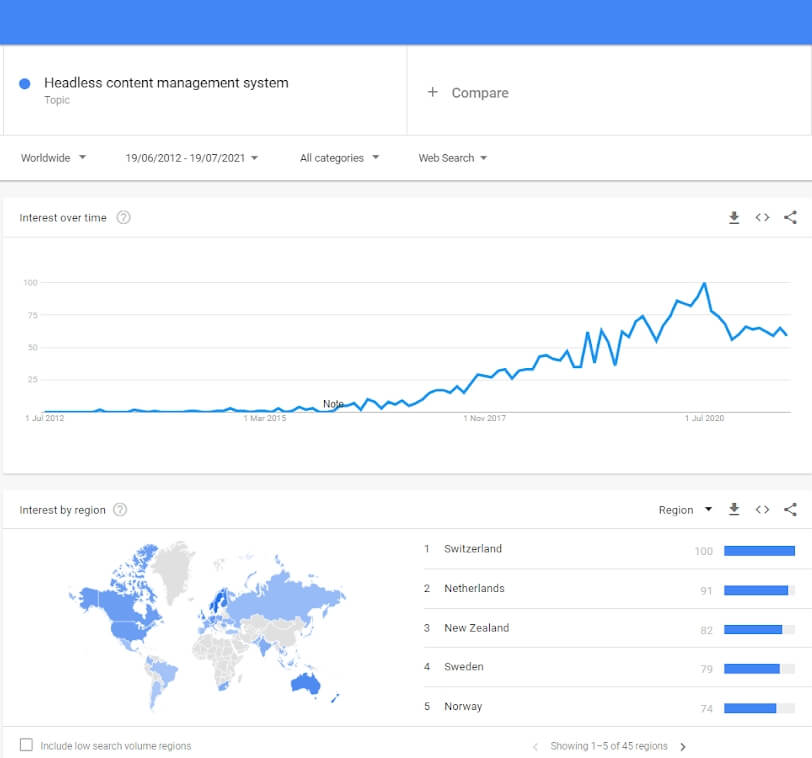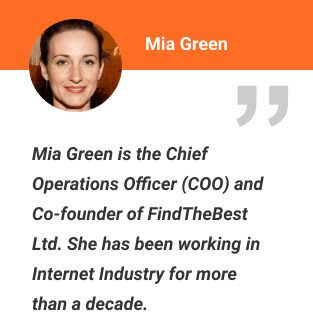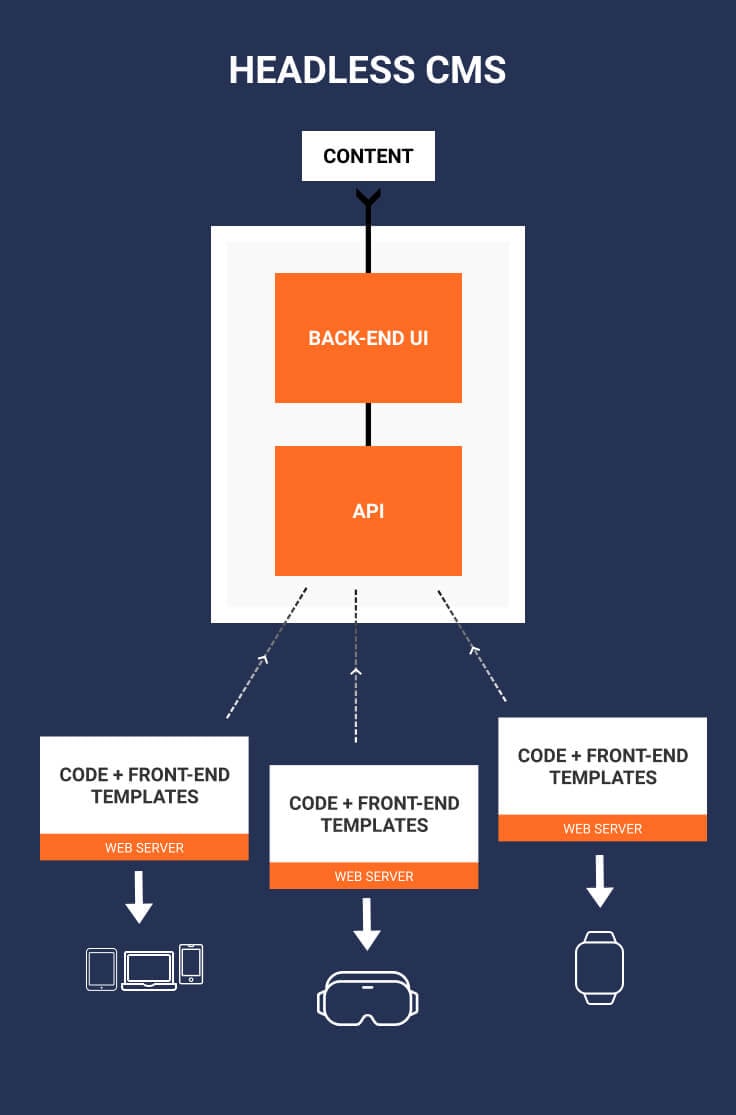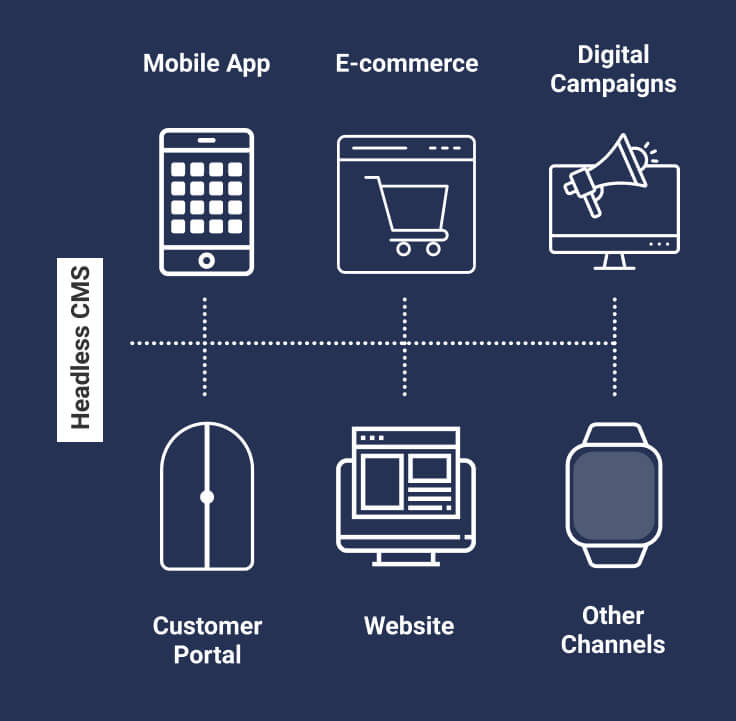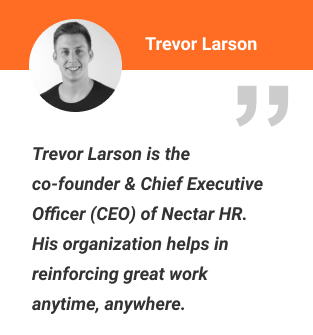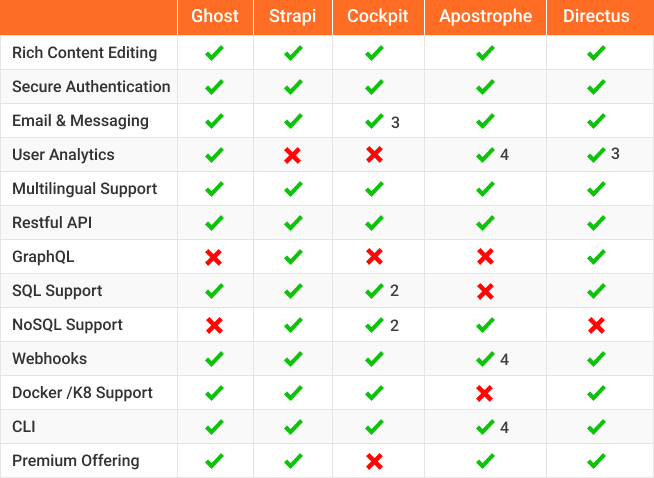Headless CMS - The Complete Guide for 2024
GET A QUOTE NOW 100% Confidential and Secure
- Headless CMS - Introduction
- What is a Headless CMS?
- Other Types of CMS
- How does Headless CMS Work?
- Use Cases For Headless CMS
- Advantages of Headless CMS
- Disadvantages of Headless CMS
- Who uses Headless CMS?
- Why Choose Headless CMS Over Other CMS?
- Headless CMS vs Traditional SMS
- How to choose Headless CMS?
- Best Headless CMS Providers
- 1. Contentful
- 2. Strapi
- 3. Sanity
- 4. Storyblok
- 5. Agility CMS
- 6. Spryker
- 7. Zesty.io
- 8. Quintype
- 9. Magnolia
- 10. Saleor
- Open Source Headless CMS
- SaaS Headless CMS
- What is Content as a Service?
- Headless CMS API Types
- Top Companies using Headless CMS
- The Final Thought
Headless CMS - Introduction
Traditional CMS has been a standard since the early days of web development. But modern-day businesses and companies are looking for flexibility and scalability, which is offered by Headless CMS.
Headless CMS is a rising trend and definitely the future of digital content management. The term CMS actually refers to the Content Management System.
Many businesses, right from multinational companies, and large enterprises to SMEs, and startups, now consider a Headless Content Management System, i.e., Headless CMS, for running and managing their content channels. They no longer prefer WordPress or any other traditional CMS.
Yet, many more switched to Headless CMS from their current CMS. It is not just a random thought of ours but a factual research study. A recent report by BusinessWire says that the “ Headless CMS market is projected to reach $1,62 Billion by 2027, and is expected to grow at a CAGR of 22.6% from 2020 to 2027. “
The increase in Headless CMS has shown a spectacular rise in the past few years. The main reason for businesses switching to headless CMS is the freedom it offers.
These results are seen in Google Trends as well. Lots of people are searching “Headless Content Management System” as shown in the below graph.
Compared to 2012, the popularity of Headless CMS is skyrocketing these days. Also, the data shows that all the developed nations have adopted it.
There are so many small pieces of information around Headless CMS on the internet currently that it can be quite challenging to understand whether it could be helpful for your business, especially for someone who is new to it.
This complete guide of Headless CMS will cover all the details you need to know from the basics. So, let’s get started with the definition of Headless CMS.
Let us begin with the definition of Headless CMS.
What is a Headless CMS?
A Headless CMS or Headless Content Management System is a backend-only content management system that acts as a content repository. Headless CMS manages and organizes content without the front end or the presentation layer. The content that is stored in Headless CMS is delivered via API across different devices.
The term ‘ Headless ‘ comes from the concept of removing the head from the body. Here the head is the front end, and the body is the back end.
The Headless CMS is where your content is stored. Then with the help of API (RESTful or GraphQL), you can distribute the content wherever you want. Through Headless CMS, content can be shared on your website, mobile device, tables, smartwatches, email campaigns, CRM, other marketing campaigns, etc.
The Headless CMS is also called API-first CMS. While some Headless CMS providers also market their CMS products and services as ‘Content Hubs,’ ‘Content Infrastructure,’ ‘SaaS CMS,’ or even ‘Content as a Service.’ However, when you take a detailed look, they all have similar Headless CMS architecture.
When asked about Headless CMS by an expert, here is how Mia Green, The Chief Operations Officer (COO) and Co-founder of Find This Best responds to “ what is a Headless CMS “ :
“ The headless CMS is a more flexible version of CMS. In traditional CMS, HTML, CSS, and content are all put in one place which makes the reuse of content difficult. Whereas in headless CMS, the presentation layer is separated from the body. Here the head is the presentation layer. For a seamless display of content in various devices, the content is delivered through APIs. Some CMS platforms headless APIs are offered to export the content to the presentation layer. The headless CMS can be an answer to the shortcomings of traditional CMS ”.
If you are still confused about Headless CMS, then do not worry. We have covered it all. Let us begin from the basics by understanding ‘what is Content Management system.’
Content Management System
The most straightforward answer to the question, ‘what is a content management system?’ is the software or system that manages content. The technical definition of a Content Management System can be given as:
“The software that helps the user to create, manage, modify and store content without any requirement of technical expertise.”
In simpler language, Content Management System (CMS) is a tool that helps you to build a website or publish content without coding.
Content Management System is usually abbreviated as CMS.
CMS is generally used for Enterprise Content Management (ECM) and Web Content Management (WCM).
Enterprise Content Management supports multiple users at a time. ECM provides a collaborative environment by integrating Digital Asset Management, Document Management, and Record Retention.
Instead of designing and developing your customized software for creating web pages, storing content, and other functions, the content management system manages all the basic functionalities and infrastructure so you can focus on your website and other areas of business.
WordPress, Joomla, Drupal, Wix, and many more are the most common content management system examples.
Now that you know what is a content management system, let’s move further ahead. There are different types of content management systems available in the market. Let us take a brief look at each type of CMS.
Types of Content Management System
There are majorly five different types of content management systems. Understanding each content management system will help you in choosing the best option for your business. So here are five popular types of CMS to organize your digital content.
Document Management System
A Document Management System is simply an automated software for organizing, digitizing, tagging, securing, approving, capturing, managing, and completing tasks associated with your business documents.
DMS digitalizes the interaction of an organization with its documents and reduces the use of paper. Majority of DMS stores data in the cloud.
Benefits of DMS
- DMS is Eco-friendly and saves a lot of paper.
- DMS has multi-layered security. It ensures that confidential documents stay safe and are only accessible by authorized people.
- Remote management of documents is possible with DMS.
- DMS lets you access documents from different devices.
Explore more about “ Document Management System “
Enterprise Content Management System
Enterprise Content Management System is a solution designed to manage an organization’s documents. Multiple formats of documents, including unstructured information, are stored and made available to the right audience at the right time.
With ECMS, every member of the organization can access the content they require for their work. In addition, it can automatically delete files after a while to free up unnecessary storage space.
Benefits of ECMS
- ECM or ECMS is highly flexible. It lets you access, capture, and store files automatically from any location.
- ECM increases business productivity and efficiency by managing documents with ease.
- ECM reduces storage costs and manages storage by deleting unnecessary files automatically.
Explore more about “ Enterprise Content Management System “
Web Content Management System
A Web Content Management System is a type of CMS that can manage digital content on a website without prior knowledge of programming or HTML and CSS. Unlike other CMSes, WCMS is designed explicitly for managing web content. It also helps in controlling, maintaining, caring, and reassembling the content on the web pages.
Benefits of WCMS
- WCMS lets users customize a webpage with personalized content and design.
- WCMS is time and resource-efficient as it publishes content automatically.
- Managing web content becomes easy through WCMS as it improves workflow management.
- WCMS is highly scalable. It allows the company to grow without worrying about website limitations.
Explore More about “ Web Content Management System “
Digital Asset Management System
Digital Asset Management System (DAM) provides an effective solution for organizations storing, organizing, retrieving, finding, and sharing digital content. DAM offers a simplified and centralized library where content is stored and accessed by clients, employees, or contractors. It is generally cloud-based so that content can be accessed from remote locations.
Benefits of DAM
- DAM has a centralized repository, so content is stored and available at a singular point.
- Publishing content through DAM is easy as it allows to push content to third-party distribution.
- Brand Management can be carried out effectively through DAM.
Explore more about “ Digital Asset Management System “
Component Content Management System
A Component Content Management System (CCMS) is a type of Content Management System that manages content at the component (granular) level instead of the document level. CCMS also tracks versions, metadata, and links associated with components. It gives full control over the content.
It is designed to maximize the content’s use so that each component is stored only once. It also acts as a trusted source for public content on multiple platforms.
Benefits of CCMS
- The reusability of content in CCMS is high. Also, it saves writing, editing, and publishing time.
- CCMS allows you to track your content in detail.
- With CCMS, users can publish content on multiple platforms, channels, and devices.
- CCMS improves workflow, team collaboration, and access in remote working.
Explore more about “ Component Content Management System “
Apart from these five types of content management systems, there are some other types of CMS, or you can say modern-day categories of CMS. Let us also understand them.
Other Types of CMS
In today’s world, every industry is under rapid transformation. The business requirements are evolving, and we need more than a basic content management system to fulfill those requirements. Here are the modern-day advanced content management systems.
Traditional CMS
A traditional CMS is a monolith that connects the back-end and front-end of a website in a simplified application. It contains both, your database needed for the content as well as your website’s presentation layer.
Before the CMS era, users had to upload HTML pages manually through the FTP protocol. But now, having a CMS and website design in one place makes it easy to manage and quick to update.
Benefits of Traditional CMS
- The entire website is managed from a single point.
- Content management becomes easy.
- Ease of control on front-end design through templates.
- Large community support is available.
- Technical barriers are minimized.
- Suitable for personal, small business, SMEs, and enterprise websites.
Headless CMS (or API-First CMS)
A Headless CMS or API-First CMS is a back-end-only CMS where the content repository and presentation layer are separated from each other. It has empowered non-developers to create and edit content without any knowledge of coding.
Whereas traditional CMS is monolithic, headless CMS deals with content only. It allows users to publish content on multiple platforms, devices, and channels through APIs.
Benefits of Headless CMS or API-First CMS
- Content can be served to multiple devices through API.
- As an author and publisher, you can focus on content.
- You can choose multiple front-end frameworks for publishing.
- Managing and publishing content becomes easy.
Decoupled CMS
A Decoupled CMS separates the back end and front end of the system. It allows teams to utilize the back-end for storing, managing, and organizing content, whereas exposing front-end systems to render the content to a particular channel.
In short, A decoupled CMS consists of two different systems that can transact easily without being connected. Decoupled CMS allows you to make changes in presentation and behavior (coding) without affecting the content.
Benefits of Decoupled CMS
- Decoupled CMS allows developers to excel on front-end technologies.
- Decoupled CMS allows you to deliver content on multiple platforms and multiple channels.
- Decoupled CMS improves performance and reliability.
- Decoupled CMS provides high security.
- A lot of time and effort is saved due to Decoupled CMS.
Now I guess you understand different types of Content Management Systems (CMS) very well. This basic knowledge about CMS will help you to understand Headless CMS in a better way.
So let’s get back on track and concentrate on the working of Headless CMS.
How does Headless CMS Work?
The working of a Headless CMS is as follows:
- It provides an author and editor with an interface for managing content.
- It distributes content via API for developers to build applications.
Thus as shown in Headless CMS architecture, it does not have a definite front-end or presentation layer. The content can be published to any front end via APIs.
A headless CMS separates the head from its stake, and now it has nothing to do with the design or the presentation. So, software developers can build the website hassle-free and use the APIs to access the content from CMS.
Most of the headless CMSes are offered as SaaS (Software as a Service) applications. This means that the user can use it as a web application, and the APIs are hosted in the cloud-based back-end. Thus, a Headless Content Management System follows a microservice architecture.
Even though some Headless CMS providers let you host the entire solution on your database and server, you still have to take care of the scaling and other operations in such cases.
Use Cases For Headless CMS
There are lots of use cases for Headless CMS. This is the beauty of Headless CMS as it can be helpful in every business to meet its unique requirements.
However, some use cases are seen frequently in comparison to others.
So here are the use cases in which Headless CMS outperforms other CMSes.
- Headless CMS is useful when separating content from your website’s front end (Tech Stack).
- Websites and Web Applications that use JavaScript Frameworks like Vue.js, Next.js, React.js, etc.
- Websites created with static site generators. (Gatsby, 11ty, Jekyll)
- To enrich your eCommerce platform.
- Use it for your product to schedule a new feature release.
- Native Mobile app development (Android, iOS, Windows Phone)
- To push content across multiple channels and platforms.
- To improve product information on eCommerce sites.
- Improve experience on existing web applications and mobile apps.
- Digitally native startups.
Besides so many use cases, there are many benefits of Headless CMS. Let us take a look at them.
Advantages of Headless CMS
Each user leverages different advantages of Headless CMS. In contrast, some common ones are listed below.
Manage Content for Multiple Channels
With Headless CMS, content can be pushed to multiple channels. As the number of devices and channels engaging with content has increased, Headless CMS is the solution.
It fits the general content marketing through COPE strategy (create once publish everywhere).
Faster Content Editing
A traditional CMS user has to spend time, effort, and resources on content management and editing. Whereas Headless CMS users can avoid it. They do not have to deal with the rendering side of things.
Higher Flexibility
As the content is served through APIs, there is high flexibility in using Headless CMS. Developers can work with different technologies and frameworks without having to worry about content. Whereas, content can be published independently of the front-end.
Future Proof Business
Headless CMS is compatible with all the latest technologies in the market. It also lets your business perform better compared to other CMS. Besides, as seen ahead, its trend is snowballing.
High Scalability
Headless CMS lets you manage your content from a single point. It allows developers to make changes with frameworks, languages, and tools without affecting the content. And with Headless CMs, you can send content to cloud-based hosting. So in this manner, Headless CMS lets you scale without affecting the rest of your infrastructure.
Improved Security
There is just a singular point of connection between the content and the tech stack with Headless CMS. So the surface area that can be attacked is significantly less compared to the traditional system.
Compatibility
Headless CMS is compatible with publishing content on multiple devices, platforms, and channels. Apart from this, it is also compatible with all tools and frameworks so developers can have a free hand.
Explore more about “ Top 7 Advantages of Headless CMS ”
Disadvantages of Headless CMS
Though Headless CMS has so many benefits, it comes with a few disadvantages for some of its users. Here is the list of them.
- You need to manage the infrastructure and presentation of your site or app independently. (Though it is an advantage for many)
- You need to pay differently for CMS, front-end, and back-end management. Sometimes it can be costly if not done in the right way.
- Headless CMS can not be highly customized on its own.
- Shifting to headless means, you may temporarily lose some of the functionalities of your current CMS.
Who Uses Headless CMS?
Headless CMS is perfectly suited for organizations and businesses aiming to create a better customer experience. Regardless of the industry, vertical, or size, every business can benefit from the adoption of Headless CMS.
However, CMS is highly beneficial for business that deals with content and eCommerce elements.
Headless CMS allows businesses and companies to connect with a larger audience and scale rapidly. Also, it is useful to those who respond quickly to opportunities in emerging markets.
Headless is definitely for those who wish to streamline their content operations and enforce consistency within their business processes.
When asked the question to the experts, “ which type of industries, organizations, and users can use Headless CMS and get benefits from it? “
Trevor Larson, the Co-founder & CEO of Nectar, quoted the following response.
“ Headless CMS is an excellent tool for managing digital presence, so it is used across industries, mainly eCommerce and online retail. However, the digital marketing industry is the primary benefactor because it makes omnichannel and IoT content marketing much more efficient.
Headless CMS is a great enabler, in this sense, because it allows companies with rapid go-to-market strategies to avoid spending an exorbitant amount of time creating solutions. Headless CMS is built to facilitate scalable, agile content management, making them valuable to any company with a significant digital presence.”
Thus Headless is the solution for each and every industry that deals with digital information. And nowadays, there is no such industry that does not deal with digital content at all.
So if you ever come across the question ‘is Headless CMS beneficial for me?’ Then the answer is definitely yes.
Why Choose Headless CMS Over Other CMS?
Every user who comes across Headless CMS always wonders why it is so popular And that why should they consider adopting Headless CMS for their business.
But the time to choose Headless CMS can not be more evident than now. Here are the top 10 reasons you should consider Headless CMS over traditional CMS or any other CMS.
- Headless CMS is faster, easier, and highly flexible to develop on.
- Headless CMS is surely future-proof.
- Headless CMS support multichannel as well as omnichannel architecture.
- Headless CMS is highly cost-efficient.
- Headless CMS is highly scalable.
- Headless CMS is easier to learn and to use.
- Headless CMS is always up to date (Evergreen).
- Headless CMS leads to better software architecture.
- Headless CMS allows less specialized and smaller teams.
- Headless CMS lets you focus on your business.
Explore more about ” Why Headless CMS Will Replace WordPress “
Now you know the reasons for choosing Headless CMS, let us dive further into the difference between headless CMS and traditional CMS.
Headless CMS vs Traditional SMS
If there is still some confusion about how Headless is different from traditional CMS (coupled CMS), this comparison between Headless CMS and Traditional CMS will surely sort it out. It will also help you to choose the best Headless CMS for your business.
| Headless CMS | Traditional (Coupled) CMS |
| Headless CMS has decoupled front and backend. | Traditional CMS is monolithic. |
| It has frontend freedom. | It is template-driven and does not have frontend freedom. |
| It is suitable for websites, applications, and any other devices. | It is only suitable for websites. |
| With Headless CMS, it is easy to get the high performance of your website. | In traditional CMS, optimization is needed to get good performance of your website. |
| Requires development resources and a skilled team to set up and maintain. | Requires a small team to set up and maintain. |
| Best-in-class modern frameworks, tools, and technologies can be leveraged. | Proprietary frameworks and templating engines can only be leveraged. |
| Serverless function extension model. | Plugin extension model. |
| Completely and highly scalable. | Scalable only linearly. |
| Highly secure. | Comparatively less secure. |
| Headless CMS is flexible. | Traditional CMS is rigid. |
| Provide complete control over how and where your content can be published. | Traditional CMS does not provide complete control. |
| It is future-proof and trending. | The trend is more shifting towards Headless CMS from traditional CMS. |
| Its architecture mainly consists of backend + API. | Its architecture mainly consists of the backend + frontend. |
| It does not have any design constraints. | There may be design constraints. |
| You can create a customized experience for users and admins. | It has a pre-defined experience for users and admin. |
Explore more about “ When Should You Switch From Traditional CMS To Headless CMS ”
How to choose Headless CMS?
There are lots of Headless CMS options available in the market. And it can be challenging to navigate through so many of them. As every CMS has different features from others, choosing the right headless content management system can be tricky.
A CMS you tend to choose should let you grow and adapt to your current and future needs. So, we have curated a list of questions that you can ask yourself before choosing the right CMS from broadly available Headless CMS options.
- How does it manage files and other assets?
- Can I scale my content operations with this headless content management system?
- Would I need to look after content hosting and management by myself?
- Will my content be secure with this Headless CMS provider?
- Would using this CMS improve my workflow?
- Does this particular Headless content management system match my requirements?
The above-mentioned questions would simplify the search for the best-suited Headless CMS for you. Though, there are lots of other factors necessary for choosing a suitable CMS.
Explore more about “ 7 Steps To Choose Right Headless CMS ”
Best Headless CMS Providers
Choosing the right headless content management system can be tough. So to simplify it, we have listed out the top 10 best Headless CMS to look for in 2023. These are the most common Headless CMS examples (paid and free) in the current market.
1. Contentful
Contentful is one of the best Headless CMS and API-driven platforms. It was founded in 2013. The content infrastructure of Contentful provides RESTful API to integrate, manage and deliver content. It also allows programmatic control of digital assets.
Content can be managed and can be edited with any device. It also works with all the frameworks, tools, and languages. Thus it is an entirely Headless CMS.
The basic pricing of a contentful community is free, while for a team (pro), it is $489 per month and custom plans are available for enterprises.
2. Strapi
Strapi is one of the most popular and leading javascript-based open-source Headless CMS. It is built with React and can drive a large amount of dynamic content across multiple platforms and channels.
Strapi supports multiple databases, so its users have a wide range of choices. Highly customizable APIs, auto-generated documents, and one-click integration make it simple and easier to use. At the same time, it supports GraphQL and RESTful APIs for a better mobile apps experience.
The introductory pricing of Strapi is free. Whereas its bronze plan is $29 per month and silver plan is $299 per month. They also have a golden plan for customized experiences.
3. Sanity
Sanity is an industry leader among Headless CMS options. It is trusted by top corporate giants like National Geographic, Nike, Sonos, Cloudflare, Eurostar, Invasion, Netlify, and many more.
Sanity is highly adaptable and flexible. It engages with all types and sizes of organizations. Also, complete control over the CMS allows businesses to scale rapidly using Sanity. It is one of the best Headless CMS available in the market.
The basic pricing of Sanity is free. While its Team and Business plans are $99 and $949 per project/month, respectively. It also has an Enterprise plan for customizing the CMS with a custom software development company.
4. Storyblok
Storyblok is a Headless CMS with a visual editor for non-tech users. It is based in Austria and was established in the year 2017. It is purely a headless content management system that generates API and works with multiple devices and platforms.
With advanced Headless CMS architecture behind it, Storyblok enhances the client experience of page building. This gives complete freedom and control to developers and front-end users. Pizza hut and Adidas are some well-known clients of Storyblok.
There are a total of five pricing modules of Storyblok starting from entirely free for a single developer. For basic, it is $7. The Advanced module is $12, whereas, for the premium, it is $21. They offer a plan for an enterprise that is $1999 per month.
5. Agility CMS
Agility CMS is a content-first Headless CMS that publishes content via API so users can choose whichever programming language they want. It gives them the speed, flexibility, and power of lightweight APIs.
It allows you to build what you want and how you want. It has the combined advantages of RESTful APIs, JAMstack, and Open Source SDKs. Agility CMS is truly satisfying for all types of users.
The basic fee of Agility is free for up to 5 users. And its pro versions are $47/mo and $579/mo. It also has enterprise plans from $2500/mo.
6. Spryker
Spryker is a Headless CMS that lets you get your business to the next level. It makes sure that you are always connected to B2B and B2C customers.
It is an API-based CMS that allows you to publish your content on multiple channels. Integrating Spryker is easy and reliable with other tools and technology.
The pricing of Spryker is not fixed. They have quote-based pricing for their customers.
7. Zesty.io
Zesty.io is a future-proof SaaS-based Headless CMS suited for all ranges of business. It is trusted by top enterprises such as SONY and Epic Games as it empowers to build desired content and publish it to multiple devices without depending upon the developer’s resources.
Zesty.io allows to increase content production, maximize business value, record valuable user data, and optimize marketing efficiency.
The pricing of Zesty.io starts from $475/mo for startups. The other plans include silver, business gold, and business premium at the price of $1250/mo, $3500/mo, and $8500/mo, respectively. They also offer custom-tailored plans for enterprises.
8. Quintype
Quintype is a Headless CMS that understands your content and your requirements very well. It allows omni-channel distribution of content and previews it before publishing.
The in-depth analytics and SEO features offer a better digital experience. At the same time, the set of features provided by Quintype makes it one of the most user-friendly platforms.
Its basic price starts from $99/month. They also provide custom plans for enterprises that are quote-based.
9. Magnolia
Magnolia offers the capabilities to create, manage and deliver content with ease across multiple channels. It allows users to manage content independently without relying on developers.
With Magnolia, developers can easily work with any technology they want and integrate it with other tools and technology.
When it comes to pricing, Magnolia does not have fixed pricing. They offer quote-based pricing depending on the user’s requirements.
10. Saleor
Saleor is an open-source platform that works with GraphQL APIs. It delivers ultra-fast, personalized, and dynamic experiences.
With its highly flexible APIs, users can have a true omnichannel experience. Being an Open Source CMS adds more advantages to Saleor.
The basic pricing for Saleor is free. In contrast, the hosted prices of the startup, pro version, and enterprise package are $695/mo, $1795/mo, $6795/mo, respectively.
There are just opinion-based listed Headless CMS. Apart from these CMS Platforms, there are many other CMSes that are impressive and trusted worldwide. You can compare multiple Headless CMS platforms on Jamstack, view their ratings and reviews, filter them out and choose the best-suited one for yourself. This list consists of free Headless CMS as well as paid ones. Here is the link for that list.
Explore More about “ Top 20 Headless CMS For Your Website ”
Open Source Headless CMS
As the name suggests, an open source Headless CMS is a content management system that is freely available to use without any licensing fees. An open source content management system is created and managed by the global community of talented developers worldwide. It is not owned by any single company. We can say that it is a free Headless CMS.
The source code of the open source Headless CMS is available for everyone. Any member can extend, modify and create new features with the source code that they require. In short, everyone has the right to manipulate code as per their requirements.
Open Source Headless CMS is precisely the opposite of proprietary CMS which is built and maintained by a fixed company. In case of proprietary CMS, the company owns the CMS, and the users have to pay the licensing fees to use it.
Best Open Source CMS providers
Nowadays, there are many open source Headless CMS available in the market. We have made a list of the best open source Headless CMS options. These all are free Headless CMS.
We have made a comparison between these CMSes from the features they offer. The following table shows the comparison between the best open source Headless CMS options.
The number from 1 to 4 represents:
1 – It offers its own database solution.
2 – It is limited to MongoDB and SQLite.
3 – Support is limited.
4 – Done through extensions or plugins.
Explore more about “ List of Open Source CMSes “
SaaS Headless CMS
SaaS Headless CMS refers to the Content Management System that exists in a cloud or a hosted environment. SaaS CMS is also known as cloud content management. A SaaS Headless CMS provides its users with a robust set of tools to manage the high volume of content.
Benefits of SaaS Headless CMS
There are lots of benefits of SaaS content management systems. Some of them are mentioned below.
Availability – SaaS Headless content management system is accessible anywhere, anytime with an internet connection.
Configuration – Creating a customized workflow in SaaS CMS is easy for the clients. It can align with the user’s business process.
Reliability – The availability of system resources is high, which improves the overall performance of the content management system.
Security – Secure Authentication, Features to allocate customized roles, Advance logging, and user activity tracking make the SaaS CMS highly secure.
Storage – Users can demand additional storage whenever they require it. Besides, the data redundancy features help in storage optimization.
Costs – The costs associated with proprietary content management systems are eliminated in SaaS CMS, making it cost-efficient.
Implementation – Whereas a traditional CMS requires configuration, time, and resources, SaaS CMS can be implemented quickly and leveraged for productivity in no time.
What is Content as a Service?
Content as a Service (CaaS), also known as Managed Content as a Service (MCaaS), is a method of storing and managing content in its raw form so websites, apps, and devices can use that piece of content when needed using Application Protocol Interface (API).
Unlike traditional content management systems where backend and frontend are deeply integrated, in Content as a Service (CaaS) frontend and backend are entirely separate.
The concept of Content as a Service is not new. It has just gained popularity in recent years. The reason for the increasing popularity of CaaS is due to the growing markets of AI and IoT.
Characteristics of Content as a service Platform
- Content and formatting are separate from each other.
- Access content via GraphQL or REST API.
- It allows local as well as cloud storage.
- CaaS can measure and analyze the consumption of overall content.
- Distributed authoring and workflow administration are possible in CaaS.
Explore more about “ Content as a Service “
Headless CMS API Types
To understand the Headless Content Management System (CMS) at a broader level, one must be aware of the CMS API and its types. API stands for Application Programming Interface.
API is basically a software intermediary that allows two software applications to integrate with one another. It is a set of functions that enables you to create applications that access data of other applications, services, or Operating systems (OS).
API in CMS context means that you access to content in a way that is easier to integrate with existing or new software applications. Generally, this is done by sending an API call request to an API endpoint. It is similar to visiting a webpage, but instead of a web page, you get the post’s content.
APIs are used in Software Development by developers. It makes their development process more manageable. API is a generic term, and it is used beyond CMS and software development. There are many different types of APIs, but when it comes to Content Management Systems (CMS), the most used types of APIs are REST and GraphQL.
Let us understand in brief about these Headless CMS APIs.
REST API
A REST API, also known as RESTful API, is an Application Programming Interface (API or Web API) that conforms to the design principles of REST. REST stands for representational state transfer and was developed by Roy Fielding in 2000 during his Ph.D. He developed the REST architecture style.
REST API is not a set of protocols or a standard but a set of architectural constraints. Software developers can implement REST API in multiple ways. REStful APIs provide a high level of freedom and flexibility to the developers. In fact, flexibility is the main reason APIs are used as a standard method for integrating components and applications.
There is a lot more to know about REST API. If this interests you, then you can learn more about them here.
Explore more about “ REST API “
GraphQL
GraphQL is a query language and a server-side runtime for API (Application Programming Interface) that delivers the exact data requested by clients. GraphQL makes it possible to get all the required data in a limited number of queries.
GraphQL is designed to increase the flexibility of API and make it fast and user-friendly. As an alternative to REST API, GraphQL allows developers to pull data from multiple sources with a single API call.
Apart from that, GraphQL allows users to add or remove fields without impacting the existing queries. So, developers can build API with their preferred method, and GraphQL ensures that the API will function in predictable ways for the client.
Explore more about “ GraphQL “
Top Companies using Headless CMS
Beyond the theories, every industry and vertical has embarrassed the power of Headless CMS to improve their digital experience. Headless CMS allows organizations to connect with their customers at a larger scale. Also, it helps in responding to emerging market opportunities and streamlining content operations.
Here is the list of reputed companies using Headless in one way or another.
Discovery
With the help of Headless CMS, Discovery communications accelerated its speed of content curation and published content in 50 languages across 220 countries.
Matthew Falcon, manager at discovery, says:
“GraphCMS provides an easy-to-use tool to help manage and highlight news stories related to Project C.A.T. The platform integrates seamlessly with our website and we are able to upload and distribute stories globally very quickly.”
View a complete case study of Discovery from here.
HashiCorp
The needs of HashiCorp were expanding with its business. In contrast, the CMS platform they use was not able to meet those requirements. So HashiCorp decided to switch to Headless CMS to manage sharing assets and multiple properties as well as to design and code a wide range of products.
Since implementing Headless CMS, HashiCorp leverages the benefits of faster deployments, better integrations, and a satisfactory editorial team.
View the complete case study of HashiCorp from here.
Miami Heat
Miami Heat is a famous basketball team that recently moved to Headless CMS. Now they can deliver real-time personalized experiences with Headless CMS.
According to Matthew Jafarian, Executive Vice President, Business Strategy, their previous CMS solution could not meet their business expectations at multiple levels. Besides, the licensing was costly, and customization and integrations were significant issues. The only solution to this problem was Headless CMS.
View a complete case study of the Miami Heat from here.
Apart from the companies mentioned above, many other market leaders shifted to Headless CMS and are satisfied with it. Some of these reputed names are Nike, Adidas, Pizza Hut, Spotify, Icelandair, Staples, IKEA, Burger King, PhotoBox, Wonderland, and many more. You can be one of these organizations and leverage the advantages of custom-developed Headless CMS.
Explore More about “ Step By Step Guide For Headless CMS Development ”
The Final Thought
In the end, the decision to shift to Headless CMS or not totally depends on your business goals & requirements.
As content is being created and consumed on a larger scale through multiple devices and channels, strategies are more complicated, technology is changing rapidly, and companies realize the need for Headless CMS sooner or later.
The internet is becoming a larger part of our daily lives; everything we deal with is merely content in one form or another. So, attracting potential customers or being the one indeed deals with a better user experience with the content we create.
Companies try for customers to consume their created content, absorb all the information they provide, and at the same time purchase their products and services.
This is what a headless CMS does. It connects you with the customers and provides them with a better user experience. Headless CMS is surely the future of CMS industry where content moves more freely and interacts with customers on multiple platforms, devices, and channels.
A customized Headless CMS surely delivers the desired experience to your potential customers. At the same time, it gives a free hand to your organization to implement whichever technology you want.
The tech giants like OpenXcell can customize your Headless CMS for managing content across the globe and unleash the content to whosoever uses them.
Customize your Headless CMS with OpenXcell
- OpenXcell is a renowned software development, mobile app development, and Headless CMS customization company that has been constantly delivering enterprise solutions to all the major brands worldwide.
- We have a huge resource pool of 500+ professionals that have been recruited via our extensive vetting process. Moreover, we have been in the industry for 13+ years now which helps our clients to develop their projects hasslefree and successfully with our dedicated teams.
- We have developed 1000+ solutions for our clients across the globe establishing our brand in all the major countries like the United States, Germany, Australia, United Kingdom, Europe, and Saudi Arabia.
- OpenXcell offers 360 degree support to all its clients by providing end to end solutions for their project ideas. Our expert team ensures that your CMS is customized accurately to your demands in one go.
- OpenXcell has offered its services to a wide range of businesses, including industries like education, sports, media & entertainment, healthcare, logistics & shipping, software, and blockchain.
- We offer a unique opportunity for customers to augment their development capabilities by hiring a dedicated remote staff. To ensure that only the most skilled and experienced professionals join our team, we have implemented a rigorous hiring process. To allow potential customers the opportunity to test and evaluate the capabilities of our remote staff, we offer a complimentary 7-day trial period.
To understand in more detail as to how we serve our Headless Clients, talk to our Experts!

